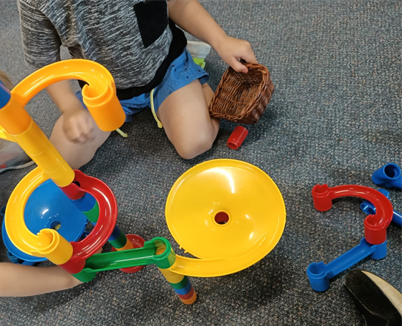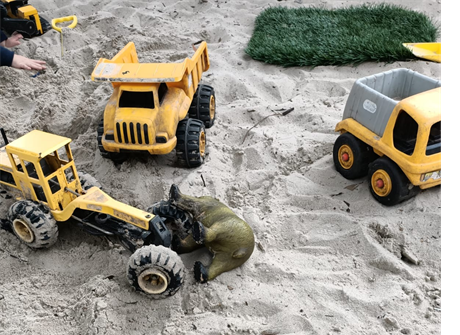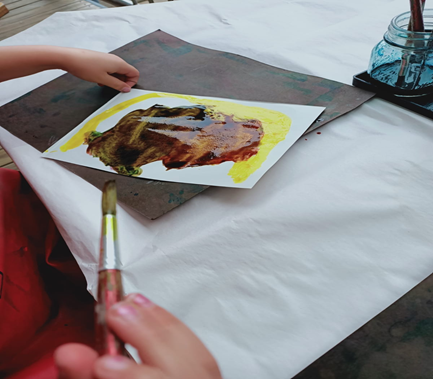Introduction
Teaching young learners about scientific concepts may seem like a difficult task, but in fact, it is quite uncomplicated when correct approaches are utilized. In the present paper, a summary of three lesson observations is given. The teaching methods used in every case are analyzed, and the relevance of their choices is discussed. The focus is made on contextual, interpersonal, and personal dimensions of learning.
Observations
Observation 1: Force, Gravity, Kinetic Motion (Christopher)
The first observation is focused on a child interacting with objects, which teaches him about gravity, force, and kinetic motion. The full text of the dialogue between the child and the teacher is given in Appendix 1. Christopher saw pieces of a Marble Run on the floor and wanted to play with them. However, the boy did not quite know how the toy worked. When he asked the teacher, he learned that he could put marbles in the Marble Run and see how they moved. With the teacher’s help, the boy managed to make a Marble Run and observed where the marbles were going. He noticed that they were descending very quickly, but then he saw that they moved faster when there was a small number of them. With the help of the game, the teacher explained the basics of kinetic motion, gravity, and force to the boy. Using preschool resources available, the teacher let Christopher try the new motion in a new play: in the sandpit.


Observation 2: Color Changing (Sancha)
The day was warm and sunny, and the teacher suggested that children play outdoors. Sancha went to the desk because she wanted to paint. The girl was trying to explore the process of colors’ changing on paper. The teacher encouraged the girl’s intention because the process of mixing colors allows experimenting and learning, and the process seems magical to young learners (“Colour mixing,” 2016; Goff & Curtis, 2019). The teacher told Sancha that yellow, blue, and red were the primary colors, and various combinations of them could result in different shades. The full text of the dialogue between the child and the teacher is given in Appendix 2. At first, Sancha mixed yellow, blue, and red, and saw that the color turned to look brown-and-black. Then, the girl tried mixing red and blue on paper and saw that together, they gave a green color. The teacher used the opportunity to encourage the child to experiment and be inquiring. The process was exciting for the girl, and she was likely to continue trying new combinations.

Observation 3: A Caterpillar’s Life Cycle (Bodhi)
The teacher noticed that children were interested in insects when they were in the schoolyard. Thus, she prepared “The Very Hungry Caterpillar” story to tell young learners more about the caterpillar’s life cycle. The teacher showed a puppet to children and asked what they thought it was (Appendix 3). Some kids said it was a worm, but Bodhi said it was a caterpillar. Further, the boy mentioned that caterpillars turn into butterflies as they grow. The teacher used puppets to show the way a caterpillar grew into a butterfly. Then, she let the children play with the puppets and recreate the story. After the play, the teacher encouraged children to look for caterpillars in the schoolyard. Bodhi found three of them, but he was afraid to touch them. The teacher suggested that several children collected them together and put them into an “insect hotel” so that later, everyone could observe how cocoons hatched into butterflies.

The Analysis of Observations
Rogoff’s (2003) three lenses of analysis are based on Vygotsky’s cultural-historical theory, and they involve the personal, interpersonal, and cultural-institutional (contextual) aspects of children’s learning. These dimensions are included in the Early Years Learning Framework (EYLF) as significant factors of children’s development (Australian Government Department of Education and Training, n.d.). The observed learning situations incorporate physical, biological, chemical, and earth science strands, which constitute a crucial part of young children’s development.
Observation 1
The contextual lens in the first observation involved the use of the child’s interest in cars (playing in the sandpit), as well as all materials around to make the process of learning more informative and exciting. The teacher’s role was critical to the play’s quality (Archer & Siraj, 2015). The interpersonal lens was manifested in the cooperation between the child and the teacher. Christopher had not had any such experience before, so it was highly relevant for the teacher to arrange positive communication. The teacher used both verbal and non-verbal language to reassure the child and make him feel comfortable and safe. The personal lens involved the child’s imagination as a significant contributor to learning (Fleer, 2018). The boy developed skills and understanding in science through the concepts of kinetic motion, force, and gravity. The child was fully engaged in the process of gaining knowledge.
Observation 2
The focus of the contextual lens in this observation was on the experiment with color mixing. Children are “intuitive scientists,” so it was not difficult to engage the girl in the process of learning (Tunnicliffe & Gkouskou, 2020). The EYLF outcome 4.2 was met in this activity since the child developed the skills of hypothesizing, experimenting, and investigating (Australian Government Department of Education and Training, n.d.). The interpersonal lens involved communication along with the teacher’s guidance. It is known that a play-based setting is a good ground for children’s scientific inquiry (Turner & Williams, 2020). Finally, the personal lens indicated that the child developed her own understanding of primary colors and experimented with the aim of finding solutions. The girl was rather active and interested, and she used her previous experience (names of colors) to enhance the process of learning new things.
Observation 3
The contextual lens of this observation incorporated natural environment and teaching materials, the combination of which enabled children to learn faster. Inquiry-based learning employed by the teacher increased the opportunities for learners to grasp the new material (Furman et al., 2019). The contextual focus was made on understanding the life cycle and respecting the environment. The interpersonal lens involved cooperative play of the children who pursued the same goal and shared equipment in the process of learning. To promote kindergarteners’ understanding, the teacher used to support and guidance, such as the storybook and puppets. Although the teacher guided children’s exploration, she arranged it in a way that learners would not feel that guidance and thought they came to important conclusions by themselves. Exploration, curiosity, and questioning are viewed as significant components of inquiry-based learning, which was utilized by the teacher (Cremin et al., 2015). On the personal lens level, the child (Bodhi) shared his previous experience.
Links to Teaching Approaches as Relevant
Observation 1
The approaches utilized in this observation were play-based and inquiry-based learning. Both of these methods were quite successful since they enabled the teacher to gain a positive result. Specifically, while playing with the Marble Run, the child was able to realize the connection between everyday concepts and scientific notions (Fleer, 2009). Fleer et al. (2014) emphasize the importance of teachers’ role in providing preschool children with meaningful science learning opportunities. Thus, since the teacher in the observed situation did her best to engage the child in scientific and inquiry-based learning, it is viable to conclude that her approach was successful. The play-based method, which was manifested through the imaginary play in the sandpit, also had a positive effect on the boy. His scientific learning was promoted through imaginative play (Fleer, 2019). As a result, the child was introduced to several important scientific concepts and even was able to do a little experiment via a game. The teacher’s approach was rather useful both at the personal and interpersonal levels of the boy’s development.
Observation 2
In this situation, the teacher utilized the discovery approach, which was quite suitable and beneficial. The discovery approach is the method enabling educators to make children learn new things through personal investigation (Campbell, 2012). The girl’s play exploration allowed her to understand the notion of primary colors, as well as to see that their combinations gave various shades. At the same time, the teacher’s guidance helped the child to make positive discoveries at the beginning of her exploration, which eliminated the child’s disappointment and boosted her interest. As Bulunuz (2013) reports, science concepts are grasped by kindergarteners much easier when they are playing rather than when they receive direct instructions from a teacher. Therefore, the use of the discovery approach enabled the teacher to gain the best results of cooperating with the child. Young learners observe phenomena and solve problems by asking questions and making investigations (Tunnicliffe & Gkouskou, 2020). In the observation, these activities and principles were quite successful and enabled the teacher to inculcate some science concepts to the girl.
Observation 3
The teacher utilized two approaches: play-based learning (puppet play) and inquiry-based learning (collecting caterpillars). Both of these ways were quite successful in that they helped to gain children’s interest and boost their knowledge. The rationale behind choosing the inquiry-based approach was that young children “are intrinsically curious” about the world in which they live (Marian & Jackson, 2017, p. 221). Therefore, by suggesting kindergarteners look for caterpillars and put them in the “insect hotel,” the teacher supported their natural need for exploration and promoted their desire to learn about their environment. Additionally, the teacher was able to explain the role of insects in nature and teach children that some of them evolved into much more beautiful creatures than they looked initially. Play-based learning, which involved puppets, boosted children’s imagination and ignited their search for answers to interesting questions. As a result of using the selected approaches, the teacher developed children’s knowledge in science and biology.
Conclusion
The observation of several lessons with pre-school children gave many useful insights. Specifically, such approaches as inquiry-based learning, discovery and play-based learning have proven to be highly productive when working with young children. Also, the usefulness of contextual, personal, and interpersonal dimensions has been found. Teachers should use the kindergarten period to boost children’s imagination, inquiry, and exploration. With the right approach, they will gain the best educational outcomes for their young students.
References
Archer, C., & Siraj, I. (2015). Measuring the quality of movement-play in early childhood education settings: Linking movement play and neuroscience. European Early Childhood Education Research Journal, 23(1), 21–42. Web.
Australian Government Department of Education and Training. (n.d.). Belonging, being & becoming: The Early Years Learning Framework for Australia. Web.
Bulunuz, M. (2013). Teaching science through play in kindergarten: Does integrated play and science instruction build understanding? European Early Childhood Education Research Journal, 21(2), 226–249. Web.
Campbell, C. (2012). Teaching approaches. In C. Campbell & W. Jobling (Eds.), Science in early childhood (pp. 54–67). Cambridge University Press. Web.
Colour mixing – What kids learn from this simple art activity. (2016). Picklebums. Web.
Cremin, T., Glauert, E., Craft, A., Compton., A., & Stylianidou, F. (2015). Creative little scientists: Exploring pedagogical synergies between inquiry-based and creative approaches in Early Years science. Education 3-13, 43(4), 404–419. Web.
Fleer, M. (2009). Understanding the dialectical relations between everyday concepts and scientific concepts within play-based programs. Research in Science Education, 39, 281–306. Web.
Fleer, M. (2018). Conceptual Playworlds: The role of imagination in play and learning. Early Years. Web.
Fleer, M. (2019). Scientific Playworlds: A model of teaching science in play-based settings. Research in Science Education, 49, 1257–1278. Web.
Fleer, M., Gomes, J., & March, S. (2014). Science learning affordances in preschool environments. Australasian Journal of Early Childhood, 39(1), 38–48. Web.
Furman, M., Luzuriaga, M., Taylor, I., Podestá, M. E., & Jarvis, D. (2019). From inception to implementation: An Argentine case study of teachers enacting early years inquiry-based science. Early Years, 39(4), 408–425. Web.
Goff, L., & Curtis, D. (2019). Look, listen, learn. Mixed-up color mixing. Teaching Young Children, 12(2). Web.
Marian, H., & Jackson, C. (2017). Inquiry-based learning: A framework for assessing science in the early years. Early Child Development and Care, 187(2), 221–232. Web.
Rogoff, B. (2003). Development as transformation of participation in cultural activities. In B. Rogoff (Ed.), The cultural nature of human development (pp. 37–62). Oxford University Press.
Tunnicliffe, S. D., & Gkouskou, E. (2020). Science in action in spontaneous preschool play – An essential foundation for future understanding. Early Child Development and Care, 190(1), 54–63. Web.
Turner, N., & Williams, E. (2020). Early years science in action. Early Child Development and Care, 190(1), 3–11. Web.
Appendix 1
Observation 1: Force, Gravity, Kinetic Motion (Christopher)
Christopher: What is this?
Teacher: This is a Marble Run. You can put a marble in the Marble Run.
…
Christopher: Oh! Look! The marble is going down. It is very fast!
Teacher: Where does the marble go?
Christopher: It’s on the ground.
Teacher: Why do you think that happened?
Christopher: …
Teacher: Let’s find it out.
(Christopher tried to put many marbles in the run. He waited for few seconds. However, the marbles were not moving)
Christopher: Why they are not moving?
Teacher: Would you like trying to give them a push?
Appendix 2
Observation 2: Color Changing (Sancha)
Teacher: What colors do you have on your desk?
Sancha: Yellow, blue and red.
Teacher: Do you know these three colors are called primary colors? What will happen if you mix these colors together?
Sancha: Hmm… its brown and black.
Teacher: Can you try mixing other colors? What color mix with blue will be purple?
Sancha: Yellow?
Teacher: Let’s try it on the paper and see what happens.
(Sancha tried few times and found out blue and red will be purple)
Teacher: What about green? What two colors can you mix it of?
Appendix 3
Observation 3: A Caterpillar’s Life Cycle (Bodhi)
Teacher: Does anyone know what this is?
Children: A worm?
Bodhi: It’s a caterpillar!
Teacher: Oh! Very good Bodhi! Does anyone know what caterpillars become when they grow up?
Bodhi: A butterfly!
Teacher: Okay, let us find out whether Bodhi’s answer is correct or not.
…
Teacher: Would you like to go search for caterpillars in the school yard and bring them here?
(Bodhi and his friends found three caterpillars at the end of the school yard. Although Bodhi loves caterpillars, he was a bit scared to put them into a container)
Teacher: Bodhi, would you like to work with your friends to collect those caterpillars?
